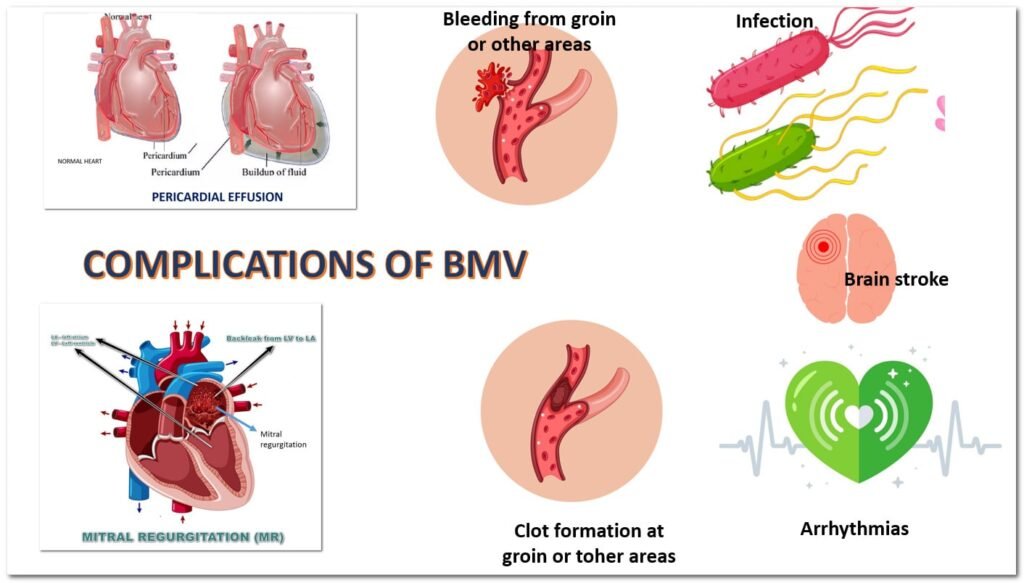Balloon Mitral

A balloon mitral valvuloplasty is a process to extend a restricted heart valve and improve blood flow. The heart valves handle how blood drives through the heart.
If one of the heart valves hardens or narrows, your heart may not pump blood properly. Your surgeon uses a tiny, hollow pipe to put a reduced balloon in your heart valve. When the balloon grows, it spreads your heart valve.
Types of Balloon Mitral Valvuloplasty Techniques
Different types of BMV techniques are employed based on the specific method used for valvuloplasty:
- Inoue Balloon Technique : This technique involves the use of a single balloon catheter introduced through a vein in the leg and guided to the heart. The balloon is positioned across the narrowed mitral valve and inflated, stretching the valve and improving blood flow.
- Double-Balloon Technique : This approach uses two balloons simultaneously to dilate the mitral valve. One balloon is placed on the left atrial side, and the other is placed on the left ventricular side of the mitral valve.
- Multi-Track Technique : In some cases, multiple wires or catheters are used to facilitate precise balloon placement and inflation. This technique allows for a more controlled dilation process and can be especially useful in complex or challenging cases.
- Balloon Valvuloplasty with Imaging Guidance
Advanced imaging techniques such as echocardiography or fluoroscopy are often used during the procedure to visualize the mitral valve and guide the placement and inflation of the balloon.
What Happens After the Balloon Mitral valvuloplasty?
After the process, you go to a healing area. If the pipe went through your heart, you’ll need to remain a few hours before turning your leg. You may lie on a mattress for approximately two to six hours, depending on multiple factors. You’ll be required to consume plenty of water to rinse the contrast dye from your body.
Procedure OF Balloon Mitral valvuloplasty
- Inserts a tiny, hollow pipe called a sheath via a blood vessel in your arm or shoulder.
- Threads a pipe with a flattened balloon through the case.
- Injects a contrast shade and utilizes X-rays to direct the pipe to your heart valve.
- Grows the balloon to spread the limited heart valve.
- Releases the pipe and seals the insertion area with small stitches or a particular surgical adhesive.
Benefits of Balloon Mitral valvuloplasty
Balloon mitral Valvuloplasty is the tiniest intrusive process. Compared to open-heart surgery, the advantages of the tiniest invasive heart therapies can include:
- Faster healing.
- Minor scarring.
- Lower chance of difficulties.
- Decreased pain.
Why Balloon Mitral valvuloplasty is done?
Valvuloplasty may be an opportunity to open a tightened heart valve(stenosis). Your doctor may suggest balloon valvuloplasty to treat these types of heart valve disease:
- Mitral valve stenosis.
- Pulmonary valve stenosis.
- Tricuspid valve stenosis.
Risks Involved in Balloon Mitral valvuloplasty
Like all medical surgeries, a valvuloplasty can lead to a state of disease or bleeding. Balloon mitral valve Valvuloplasty and radiation orientation can be dangerous to pregnant ladies and fetuses.
FAQ For Balloon Mitral
What is the cost of balloon valvuloplasty in India?
Balloon mitral valvotomy cost in India is in the range of Rs. 177600 to Rs. 236800.
What is the cause of balloon mitral valvuloplasty?
Balloon mitral valvuloplasty is a medical process used to treat a disease known as mitral stenosis, which is a narrowing of the mitral valve in the soul.
How long does mitral balloon valvuloplasty last?
The results of a mitral valvuloplasty may survive a minimum of about two years.
What is the success rate of mitral balloon valvuloplasty?
The success or win rate of mitral balloon valvuloplasty is 93% to date.
Can I live a normal life after mitral valve surgery?
One can likely be capable of doing multiple of your regular exercises after 4 to 6 weeks.
